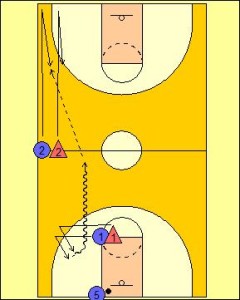Sideline Push Passing Drill
The Sideline Push Passing Drill looks to create a common moment in a team’s Fast Break or Primary Transition where a player has to judge if a pass down the sideline is the right option, or a bad option. This is often a situation which is not normally practiced in isolation and for this reason the different options available to players are often not fully realised. The Sideline Push Passing Drill looks to fill this void and provide some much needed practice for the inbounder, ball handler, and receiver in this most frantic of moments during a game.
The goal for any team in their Fast Break or Primary Transition Phase in offense is not to just only secure possession and advance the ball, but provide high percentage scoring opportunities to a number of players on the floor in quick succession. By doing this a team provides itself with the best opportunity to score as the defence is constantly in motion, a number advantage can sometimes be established and bigger driving lanes exist as players move from one end of the floor to the other.
All too often the offensive player makes a lead to receive a pass only to find themselves well outside an area on the floor where they are a direct threat to the basket by way of a jump shot to drive.
Timing is one of the key aspects within this breakdown. The Sideline Push Passing Drill will help the offensive players normally involved in this situation to better coordinate and perfect their cuts and finish in offensively functional receiver spots.

The Sideline Push Passing Drill starts with three offensive players and two defensive players involved in the activity.
The first offensive player (Five) is positioned as the inbounder. When this player slaps the ball the drill will begin.
The next group of players are positioned at the elbow. There is an offensive (Circle) and defensive (Triangle) player at this position. These players will form the outlet.
The next group of players will be at where the halfway and sideline intersect (called the “T”). These players will aim to be the first receiver down the sideline for the pass to be made towards.
One (1) creates a lead for the ball by first taking their player away from the intending catching area and then sharply leading back for the ball. The offensive player will now look to push the ball through one quick dribble into an open passing position down the sideline. If the pass is not able to be made the ball handler will continue with their dribble until a pass can be made or they reach the front court.
Once the ball is slapped by the inbounder Two (2) will take off down the sideline. Once reaching the foul line extended Two (2) will have a couple of different options at their disposal to work themselves free for their defender. The first is to “bounce” off the baseline, taking their defender away from the intended catching position (foul line extended) to the baseline before lift back towards the wing position.
The second option is for Two (2) to utilise a v-cut towards the basket before leading back again to the wing position.
Variation
An option which will make the Sideline Push Passing Drill more challenging is to also add a defender to the inbounder.

If One (1) cannot make a pass down the sideline then both offensive players must work together seamlessly to create space while still providing scoring options.
Once Two (2) recognises the pass is not going to be made by One (1). Then Two (2) will need to move back down the sideline into the long corner.
One (1) will continue to advance the ball off the dribble into the frontcourt.
The space created by Two (2) will allow One (1) to turn a corner and attack the basket with ample space for a driving lane to be established. In this situation if at any time Two (2) defensive match-up leaves to help. The Two (2) must backdoor cut to the basket looking for the pass from One (1).
Another option is for Two (2) instead of moving into the long corner to v-cut to the keyway, but stop on the lift out and look to seal their defender in the keyway.
The Sideline Push Passing Drill finishes once the offense scores or the defence secures possession.
The inbounder does not take part in the drill apart from making the initial outlet pass.
The Sideline Push Passing Drill is a really nice activity for focusing on an area which will really make a difference to a team’s offensive quickness and security with the ball. This often overlooked breakdown can be very frustrating if facing a team with well drilled defenders who stop the ball being passed up the floor. This slows a team’s offense and limiting phases of offense that can be utilised.








Leave a Reply